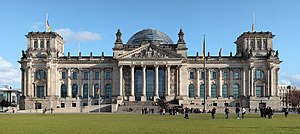| Reichstag | |
|---|---|
 The dedication Dem deutschen Volke, meaning To the German people, can be seen on the frieze above the entrance. | |
 | |
| General information | |
| Address | Platz der Republik 1, 11011 Berlin |
| Town or city | Berlin |
| Country | Germany |
| Coordinates | 52°31′07″N 13°22′34″E / 52.51861°N 13.37611°E |
| Current tenants | Bundestag |
| Construction started | 9 June 1884 |
| Completed | 1894 |
| Renovated | 1961–1964, 1992–1999 |
| Height | 47 m (154 ft) |
| Technical details | |
| Floor count | 6 |
| Floor area | 61,166 m2 (658,390 sq ft)[1] |
| Design and construction | |
| Architect(s) | Paul Wallot |
| Renovating team | |
| Architect(s) | Norman Foster |
The Reichstag (German: Reichstag, pronounced [ˈʁaɪçsˌtaːk] ; officially: Plenarbereich Reichstagsgebäude [ˈʁaɪçstaːksɡəˌbɔʏdə] , lit. 'Imperial Assembly'), a historic legislative government building on Platz der Republik in Berlin, is the seat of the German Bundestag. It is also the meeting place of the Federal Convention, which elects the President of Germany.
The Neo-Renaissance building was constructed between 1884 and 1894 in the Tiergarten district on the left bank of the River Spree to plans by the architect Paul Wallot. It housed both the Reichstag legislature of the German Empire and the Reichstag of the Weimar Republic. The Reich's Federal Council also originally met there. The building was initially used by the Reichstag for Nazi Germany, but severe damage in the Reichstag fire of 1933 prevented further use and the Reichstag moved to the nearby Kroll Opera House. The 1933 fire became a pivotal event in the entrenchment of the Nazi regime. The building took further damage during World War II, and its symbolism made it an important target for the Red Army during the Battle of Berlin.
After the war, the building was modernised and restored in the 1960s and used for exhibitions and special events, as its location in West Berlin prevented its use as a parliament building by either of the two Germanies. From 1995 to 1999, the Reichstag was fundamentally redesigned by Norman Foster for its permanent use as a parliament building in the now reunified Germany. The keys were ceremonially handed over to the President of the Bundestag, Wolfgang Thierse, on 19 April 1999. A landmark of the city is the redesigned walk-in glass dome above the plenary chamber, proposed by artist and architect Gottfried Böhm.
- ^ "Reichstag, New German Parliament | Foster + Partners". Archived from the original on 30 October 2019. Retrieved 29 October 2019.